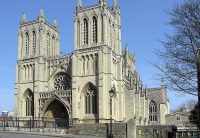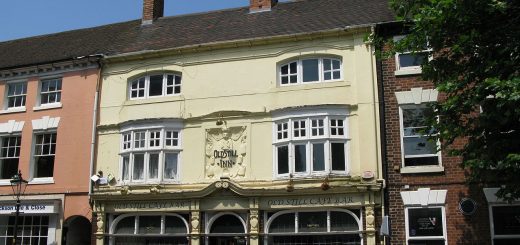Jedburgh Castle
Jedburgh’s original wooden motte and bailey castle dated back to the 12th century and was founded by King David I of Scotland (Born 1084 – Died 24 May 1153). The Scottish demolished the castle in 1409, which by then was a stone fortress with a pele tower, gatehouse and courtyard. In 1823 a Howard Reform prison was built on the site of the castle which was then closed in 1868. Since then this building has been used as a Youth Hostel and currently open to the public as the Jedburgh Castle Jail and Museum.
![Mihael Grmek [CC BY-SA 3.0 (https://creativecommons.org/licenses/by-sa/3.0)], from Wikimedia Commons](http://www.mysteriousbritain.co.uk/wp/wp-content/uploads/2018/12/Jedburgh_Castle_01-300x126.jpg) The following story from ‘The Haunted Homes and Family Traditions of Great Britain’ by John Ingram (1897), concerns the wedding at Jedburgh Castle of King Alexander III of Scotland (Born 4 September 1241 – Died 19 March 1286) and Yolande of Dreux, Countess of Montfort (Born 1263 – Died 2 August 1322) on 1 November 1285.
The following story from ‘The Haunted Homes and Family Traditions of Great Britain’ by John Ingram (1897), concerns the wedding at Jedburgh Castle of King Alexander III of Scotland (Born 4 September 1241 – Died 19 March 1286) and Yolande of Dreux, Countess of Montfort (Born 1263 – Died 2 August 1322) on 1 November 1285.
‘Even the ruins of this ancient border-fortress have disappeared, and its site is, or was recently, occupied by a large prison. But time was in Scottish history that Jedburgh boasted of an important and even magnificent castle, that was the favourite residence of royalty. William the Lion and Alexander the Second often graced it with their regal presence, but it was left to Alexander the Third to still further enhance its glory and carry its splendour to its highest pitch. The childless monarch, having determined upon marrying again, ordered the wedding festival to be kept at Jedburgh, and there, in October 1285, he was united in marriage to Jolande, or, as some style her, Joleta, daughter of the Count of Dreux.
Notwithstanding the high character borne by King Alexander, and the universal festivity and jollification, melancholy forebodings were not wanting on the occasion of this wedding. The hilarity, indeed, of the royal host and his guests was destroyed, or at all events overshadowed, by a circumstance by many deemed supernatural, and of which no explanation has ever yet been afforded. The occurrence appears to have given Edgar Poe a hint which he expanded into the tale, if such it may be termed, of The Masque of the Red Death. Whilst the wedding revelry was at its height, a figure was suddenly observed by the startled guests, gliding through their midst. In the poet’s imaginative words, the figure is described as “tall and gaunt, and shrouded from head to foot in the habiliments of the grave. The mask which concealed the visage was made so nearly to resemble the countenance of a stiffened corpse that the closest scrutiny must have had difficulty in detecting the cheat.”
“Who dares?” he makes the royal host demand, “insult us with this blasphemous mockery? Seize him and unmask him, that we may know whom we have to hang at sunrise from the battlements!” . . .
“At first, as he spoke, there was a slight rushing movement of the group of pale courtiers in the direction of the intruder . . . but, from a certain nameless awe with which the mad assumption of the mummer had inspired the whole party, there was found none who put forth hand to seize him, so that . . . while the vast assembly, as if with one impulse, shrank from the centre of the room to the walls, he made his way uninterruptedly, but with the same solemn and measured step which had distinguished him from the first.” Ultimately, the revellers take courage, and, “seizing the mummer, whose tall figure stood erect and motionless,” they “gasped in unutterable horror at finding the grave cerements and corpse-like mask which they handled with so violent a rudeness, untenanted by any tangible form!”
Less terrifying, yet not the less suggestive, are the lines of Heywood, Hierarchie of the Blessed Angels, when recounting the ill-omened tale:
In the mid revels, the first ominous night
Of their espousals, when the moon shone bright
With lighted tapers the King and Queen leading
The curious measures, lords and ladies treading
The self-same strains the King looks hack by chance,
And spies a strange intruder fill the dance;
Namely, a mere anatomy, quite bare;
His naked limbs both without flesh and hair,
(As we decipher Death), who stalks about,
Keeping true measure till the dance be out.
Nothing further is known of this spectral appearance, which had glided so suddenly into the midst of the startled revellers, and had as suddenly and as mysteriously vanished. But everyone felt that it was the portent of some great approaching calamity. Thomas the Rymer, the famous seer and prophet, informed the Earl of March, in the presence of several persons, that the 16th of March should be “the stormiest day that ever was witnessed in Scotland.” The day came clear and mild, and the scoffers laughed the prophecy to scorn, when suddenly came the news that the King was dead. “That is the storm which I meant,” said Thomas, “and there was never tempest which will bring more ill luck to Scotland.” The seer was right.
Alexander the Third, riding in the dusk, between Burntisland and Kinghorn, was thrown from his horse over a precipice, and killed, in his forty-fifth year, a few months after his marriage. When the sad news spread, causing distraction among the people, and civil war between the claimants to the vacant throne, manv thought of the dire omen which had appeared at the King’s wedding, and deemed that it had been sent to betoken his speedy and premature death.




Recent Comments